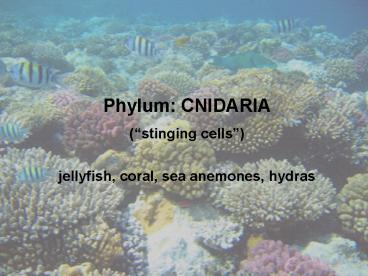Phylum: CNIDARIA - PowerPoint PPT Presentation
1 / 11
Title:
Phylum: CNIDARIA
Description:
Polyp sessile body with tentacles surrounding a mouth (coral, hydra, sea anemones) ... 1. Coral animals live symbiotically with algae - both organisms ... – PowerPoint PPT presentation
Number of Views:227
Avg rating:3.0/5.0
Title: Phylum: CNIDARIA
1
Phylum CNIDARIA (stinging cells) jellyfish,
coral, sea anemones, hydras
2
I. Characteristics
- aquatic - mainly marine
- free floating or sessile
- radially symmetrical
- nematocysts stinging cells on tentacles
3
- tentacles surrounds mouth, used to get food,
can be short or long - gastrovascular cavity space for digesting food
- nerve net network of nerves (no brain)
4
II. Body Forms
- Polyp sessile body with tentacles surrounding
a mouth (coral, hydra, sea anemones)
- Medusa bell/umbrella shaped body, tentacles
dangle and mouth is underneath (jellyfish)
5
III. Reproduction
- Asexual budding off parent (polyp body
forms do this)
- Sexual union of egg and sperm in water (medusa
body forms do this)
to float away
6
- Coral Biology
- A. Symbiosis
- 1. Coral animals live symbiotically with
algae - both organisms benefit from the
relationship - 2. Algae do photosynthesis to make food for
the coral, while the coral provide the algae
with shelter - 3. the algae give coral their unique color
- 4. Because of the algae, coral tend to live
in shallow waters so the sun can reach the
algae for photosynthesis
7
IV. Threats - Coral Bleaching A. Definition 1
. the whitening of coral colonies due to the
loss of symbiotic algae from the coral
polyps 2. the loss exposes the white calcium
carbonate skeletons of the coral
8
B. Reasons for Coral Bleaching 1. disease 2.
excess shade 3. increased levels of
ultraviolet (UV) radiation 4. sedimentati
on (sand, dirt, etc. washes into the
ocean) 5. pollution 6. salinity (salt)
changes 7. increased temperatures
9
C. Global Climate Change 1. The chief cause
is the increasing amount of greenhouse gases -
a result of human activity ? mainly CO2
from deforestation the burning of fossil
fuels 2. 1900-1999 saw the average
temperature of Earths surface rise by
0.6C ? Expect 2000-2100 to increase by
another 1.4 - 5.8C !
10
3. Sea surface temperatures have also
risen, although at a slower rate 4. In
addition to causing coral bleaching, climate
change can - change ocean circulation
patterns - increased frequency of
storm events - rising sea levels due to
expanding warm water - loss of land ice
(Antarctica, Greenland)
11
What Can We Do?































